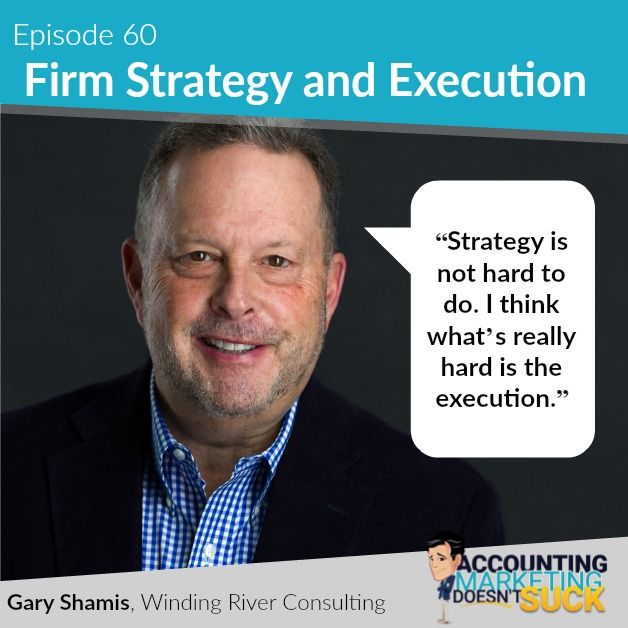Growing From $225K to $100M By Focusing on Execution with Gary Shamis
Gary Shamis talks to Hugh Duffy about why execution is harder than strategy, how developing niches can include both services and industries, and why...
4 min read
by: Gary Shamis on Jun 04, 2021
Table of Contents
Building and executing a long-term strategic plan is the cornerstone of success for every firm. And yet, managing partners often fail to set aside the time to do exactly that. The time partners spend working in the business simply doesn’t leave enough time to work on the business. This is an error that will catch up with you.
In the last four to five years, I’ve been involved in more than a dozen sales of accounting firms. Half of the time, I walk into the room to help with planning, and am unsurprised to see a group of partners who are completely unprepared to make a strategic move. In fact, the strategy side of succession planning isn’t all that complicated. All firms have two options:
Both come with challenges and opportunities.
In an ideal world, owners will pick a date of departure as early as possible. Whether you want to work until you’re 65 or work until you’re 80, you can plan a succession strategy. The date you stop working doesn’t have to be the exact date you pass the business on or sell it. Some partners end up still working at the firm after this has been done. Anticipating and planning for the date when you will no longer be in charge is invaluable to the succession planning process.
Every owner has a strategy for their firm. I strongly recommend that you take all of your ideas for growing a strong business and merge them into succession planning. Strategy has prior thought. If you have succession planning on your radar early on, it will drive the decisions you make.
As firms face these two options, it’s a useful exercise to consider value drivers. The questions I prompt owners to ask themselves have to do with priorities: what’s important to you? Is this your legacy? Do you want as much money as possible? Is it better to have the creditor be a larger firm or be internal?
Identifying primary motivators is the first step. The second is to honestly review your two options.
An internal succession requires the early identification and intentional grooming of a successor (or successors). I see many firms envision this as an option without making the investment in human capital. When I ran a firm, my goal was to have two younger people to replace every senior partner. At the end, we had 33 partners and I had to truly assess: are there 66 people to replace them? This may not be your mathematics, but the exercise is valid.
Aside from numbers, consider the dynamics of age. I recommend that you look at people no less than 10 years, preferably at least 15 years, younger than you. Most owners are baby boomers, looking at a junior workforce of millennials. These millennials have different priorities, especially when it comes to work-life balance. Depending on the culture you have built at your firm, it may not be as attractive as you think to younger people. As you gauge the possibility of internal succession, you need to consider whether it is worth it to you to make the changes needed to both equip and incentivize the next generation to take over.
Most people approach external succession in a serendipitous way. It is a realtime exercise of listing and selling, but it doesn’t have to be. In fact, owners can be much more strategic than selling to the highest bidder. It is possible to build a relationship with an acquirer. Make this process part of your long-term succession planning.
Keep in mind that your own metrics for success are the same indicators of value a buyer will look for. How many clients do you have? How profitable are you? What does your workforce look like, both in terms of capability and age? Your firm will be far more attractive if there is clear evidence that it is staffed with young up-and-comers who are well trained to lead.
The reality is this: because so many firms are not positioned to sell even though they want to sell, the market has flooded and pricing has gone down. At one time, firms thought they would sell for 1x gross revenue. For traditional firms, that number has gone down. I frame it this way: who wants to buy produce on a Sunday afternoon?
Without question, self assessment falls short here. I urge owners to get somebody from the outside to take a look at what the firm is really like and what it is really worth. Only those cold hard facts will give owners the right view of the future.
Most firms approach strategic planning for succession in a reactive way. In other words, they reach an age where they are finally considering the future and retirement, and that is when they begin to put a plan in place. While it is never too late, better results can be achieved if you get ahead of the ball.
To be proactive, consider succession planning early. Pick your end date. Groom professionals from within. Improve business practices, remembering that what makes your firm successful is also what makes it sellable. Too many firms are merging rather than selling because they lack either the internal workforce or marketplace value to do otherwise. Enlist a consultant to provide a real world assessment of what your firm is worth.
Amidst all of this focused preparation, don’t forget to benchmark your progress. There are measurable metrics for success in this kind of planning. Similar to my assessment of having 33 partners and 66 potentials for replacement, nail down your numbers: what does succession readiness look like? While this varies from firm to firm, most owners will want to analyze and measure the following:
My Managing Partner Bootcamp is an excellent resource. I have worked with nearly 100 owners and partners through the realities and practicalities of strategic planning. This includes creating a plan for succession. Someday you will want to pass the baton. Will you be ready?
Elevate your firm’s leadership: learn more about Gary Shamis’s Managing Partner Bootcamp. MPB is a personalized workshop experience. Only 12 people are accepted per session, so space is very limited.

Gary Shamis talks to Hugh Duffy about why execution is harder than strategy, how developing niches can include both services and industries, and why...

2 min read
Winding River Consulting has provided strategic growth services for dozens of the world’s Top 200 accounting firms. CLEVELAND, Ohio – Winding River...

3 min read
In a recent conversation, David Toth, Chief Growth Officer of Winding River Consulting, sat down with Tom Barry, Managing Partner of GHJ and MPB |...